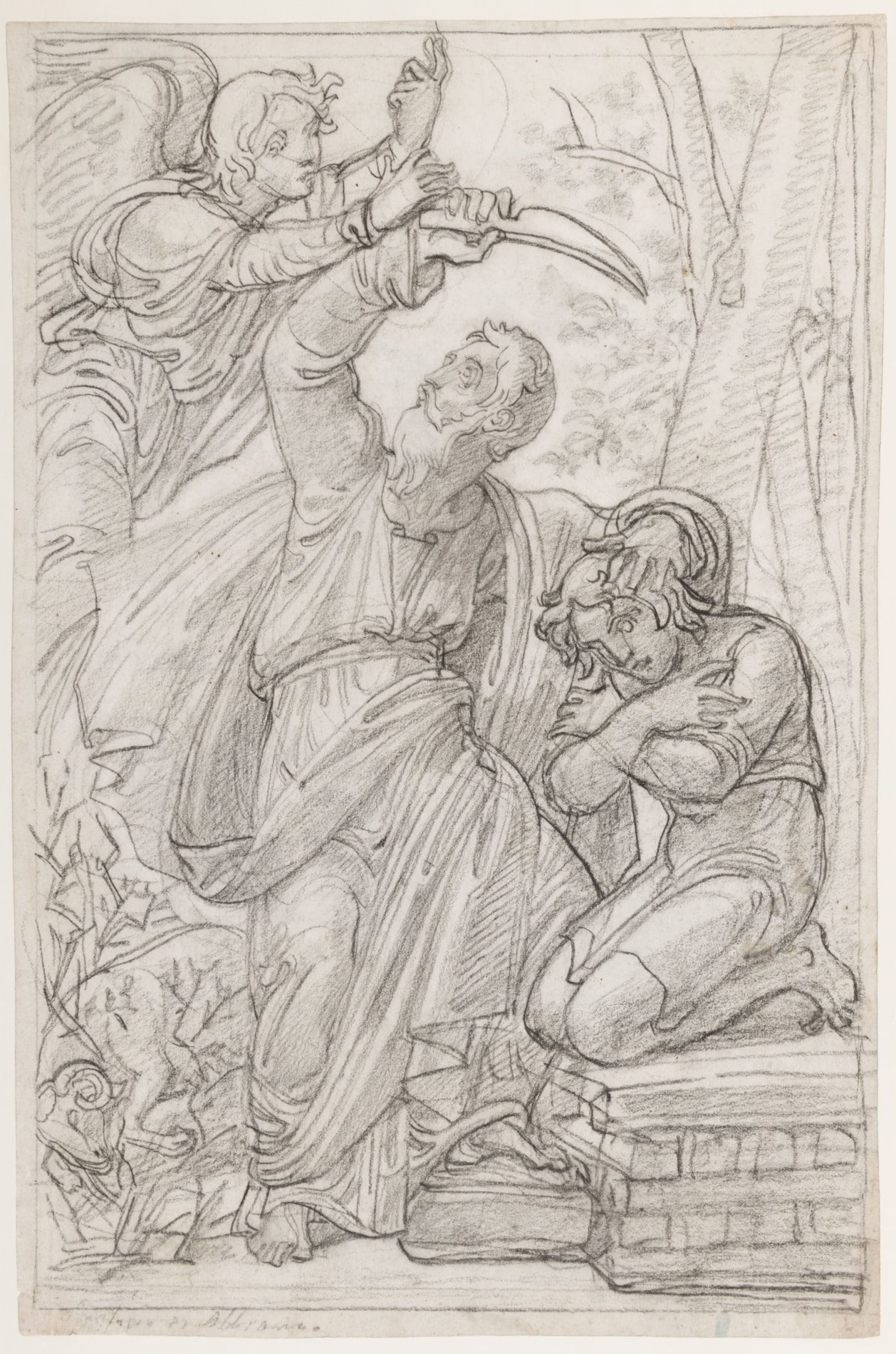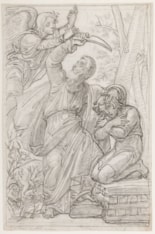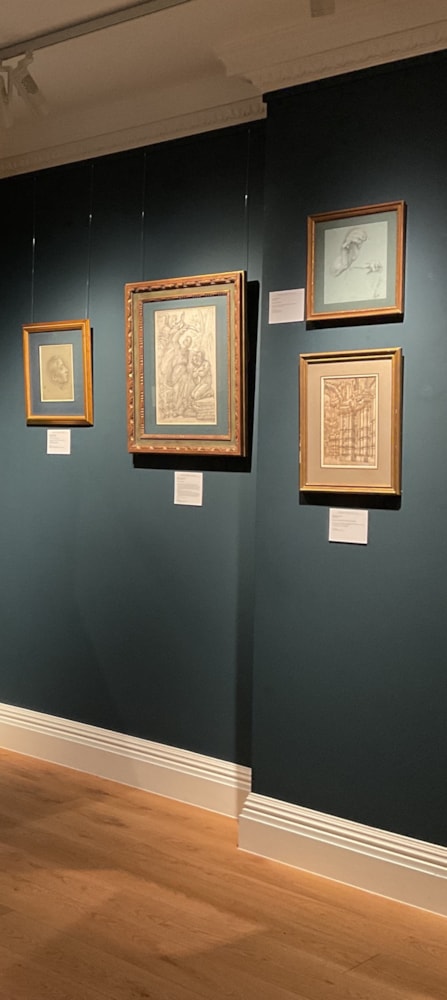Vincenzo CAMUCCINI
(Rome 1771 - Rome 1844)
The Sacrifice of Isaac
Black chalk, with stumping, and with framing lines in black chalk.
A group of three compositional sketches depicting the Resurrection of Lazarus, the Finding of Moses and another scene (the Oration of Herod?) within rectangular compartments in black chalk on the verso, along with five further empty compartments (one divided into four segments), likewise drawn in black chalk on the verso.
Inscribed Sacrificio di Abbramo at the lower left.
Further inscribed Cristo nelll’orto preso dai signori, Cristo che caccia i profanatori dal Tempio, Il risorgimento di Lazzaro, Cristo che dà le chiavi a san pietro, Ettore che rimprovera paride, Erode al popolare discorso and other indecipherable inscriptions beneath the compartments on the verso.
413 x 271 mm. (16 1/4 x 10 5/8 in.)
A group of three compositional sketches depicting the Resurrection of Lazarus, the Finding of Moses and another scene (the Oration of Herod?) within rectangular compartments in black chalk on the verso, along with five further empty compartments (one divided into four segments), likewise drawn in black chalk on the verso.
Inscribed Sacrificio di Abbramo at the lower left.
Further inscribed Cristo nelll’orto preso dai signori, Cristo che caccia i profanatori dal Tempio, Il risorgimento di Lazzaro, Cristo che dà le chiavi a san pietro, Ettore che rimprovera paride, Erode al popolare discorso and other indecipherable inscriptions beneath the compartments on the verso.
413 x 271 mm. (16 1/4 x 10 5/8 in.)
Despite being one of the most successful artists in Rome in the early 18th century, Vincenzo Camuccini had fallen into obscurity by the end of the following century, and it has only been relatively recently that he has been recognized as a significant figure in the Italian Neoclassical tradition. Born into an aristocratic family in Rome, Camuccini first studied with his brother Pietro, a picture restorer, before completing his training with a brief period in the studio of the painter Domenico Corvi. Much of his early career was spent in the study and copying of ancient sculpture and Old Master paintings – notably the frescoes by Raphael and Michelangelo in the Vatican - as well as in drawing from life. In the late 1780s, through the auspices of his brother, Camuccini began providing copies of Renaissance paintings to English visitors to Rome. It was through such connections that in 1793 he received his first important commission, from Frederick Harvey, 4th Earl of Bristol, for two monumental canvases of The Death of Julius Caesar and The Death of Virginia. Although the two paintings - each measuring some thirteen by twenty-three feet - were not completed for several years, the exhibition in 1796 of the cartoon for The Death of Julius Caesar established the young artist’s reputation. In 1804 the finished canvas of The Death of Virginia was shown in Camuccini’s studio to an enthusiastic reception, which only confirmed his position as one of the leading painters in Rome. Both large paintings are now in the Museo di Capodimonte in Naples.
By the turn of the century Camuccini was firmly established as the foremost Neoclassical painter in the city, equal in stature and influence to the sculptor Antonio Canova. In 1802 he was elected to the Accademia di San Luca, becoming principe of the institution three years later, despite being younger than the required minimum age. (He was named principe of the Accademia twice more during his career, and also worked as a professor of painting there.) Appointed director of the Vatican mosaic works by Pope Pius VII in 1803, Camuccini completed a design for a mosaic altarpiece of The Incredulity of Saint Thomas for St. Peter’s two years later. In 1809 he painted a Raphaelesque Presentation in the Temple for the church of San Giovanni in Canale in Piacenza, and the same year was made soprintendente of the Pinacoteca Vaticana. In 1813 Camuccini completed some paintings to decorate the Palazzo Quirinale in Rome for Napoleon.
From 1814 onwards Camuccini was at the height of his success, receiving numerous important commissions, both public and private. While his reputation was based largely on his history paintings, notably of scenes from Greek and, especially, Roman history, he also painted a significant number of important altarpieces and was a gifted portraitist. Camuccini’s patrons including noble and princely families in Rome and members of the papal court, as well as three Popes, the Grand Duke Alexander of Russia, and the Kings of Spain, Austria, Sardinia and Naples. From 1814 until 1843 he served as the Inspector of Public Paintings for Rome and the Papal States, and among his important works of the 1820s and 1830s were paintings for the cathedral of Ravenna and the churches of San Francesco di Paola in Naples and San Paolo fuori le Mura in Rome. Camuccini received countless honours and decorations, and in 1830 was created a Baron by Pope Pius VIII. After the middle of the 1830s, however, his output lessened, and in 1842 he suffered a stroke that ended his career.
Camuccini was a gifted draughtsman, and his drawings were highly regarded by his contemporaries; indeed, a number of fellow artists, including Giuseppe Bossi, John Flaxman and Louis Gauffier, acquired studies and sketches from him. In the early years of the 19th century he established an informal drawing academy in his Roman studio, which was attended by such artists as Bossi, Pietro Benvenuti and Luigi Sabatelli. He often sold his finished drawings as independent works of art, and also published some of them, such a series of details copied from Raphael’s Transfiguration, which appeared around 1806. A large number of drawings and oil sketches by Camuccini remained with his descendants, in the town of Cantalupo in Sabina, for several generations after his death, and groups of drawings by the artist are today in the collections of the Metropolitan Museum of Art in New York, the Istituto Centrale per le Grafica in Rome and the Albertina in Vienna.
By the turn of the century Camuccini was firmly established as the foremost Neoclassical painter in the city, equal in stature and influence to the sculptor Antonio Canova. In 1802 he was elected to the Accademia di San Luca, becoming principe of the institution three years later, despite being younger than the required minimum age. (He was named principe of the Accademia twice more during his career, and also worked as a professor of painting there.) Appointed director of the Vatican mosaic works by Pope Pius VII in 1803, Camuccini completed a design for a mosaic altarpiece of The Incredulity of Saint Thomas for St. Peter’s two years later. In 1809 he painted a Raphaelesque Presentation in the Temple for the church of San Giovanni in Canale in Piacenza, and the same year was made soprintendente of the Pinacoteca Vaticana. In 1813 Camuccini completed some paintings to decorate the Palazzo Quirinale in Rome for Napoleon.
From 1814 onwards Camuccini was at the height of his success, receiving numerous important commissions, both public and private. While his reputation was based largely on his history paintings, notably of scenes from Greek and, especially, Roman history, he also painted a significant number of important altarpieces and was a gifted portraitist. Camuccini’s patrons including noble and princely families in Rome and members of the papal court, as well as three Popes, the Grand Duke Alexander of Russia, and the Kings of Spain, Austria, Sardinia and Naples. From 1814 until 1843 he served as the Inspector of Public Paintings for Rome and the Papal States, and among his important works of the 1820s and 1830s were paintings for the cathedral of Ravenna and the churches of San Francesco di Paola in Naples and San Paolo fuori le Mura in Rome. Camuccini received countless honours and decorations, and in 1830 was created a Baron by Pope Pius VIII. After the middle of the 1830s, however, his output lessened, and in 1842 he suffered a stroke that ended his career.
Camuccini was a gifted draughtsman, and his drawings were highly regarded by his contemporaries; indeed, a number of fellow artists, including Giuseppe Bossi, John Flaxman and Louis Gauffier, acquired studies and sketches from him. In the early years of the 19th century he established an informal drawing academy in his Roman studio, which was attended by such artists as Bossi, Pietro Benvenuti and Luigi Sabatelli. He often sold his finished drawings as independent works of art, and also published some of them, such a series of details copied from Raphael’s Transfiguration, which appeared around 1806. A large number of drawings and oil sketches by Camuccini remained with his descendants, in the town of Cantalupo in Sabina, for several generations after his death, and groups of drawings by the artist are today in the collections of the Metropolitan Museum of Art in New York, the Istituto Centrale per le Grafica in Rome and the Albertina in Vienna.
Provenance
P. & D. Colnaghi, London, in 1992
Private collection, London.
Private collection, London.
Exhibition
New York and London, Colnaghi, Master Drawings, 1992, no.45.






